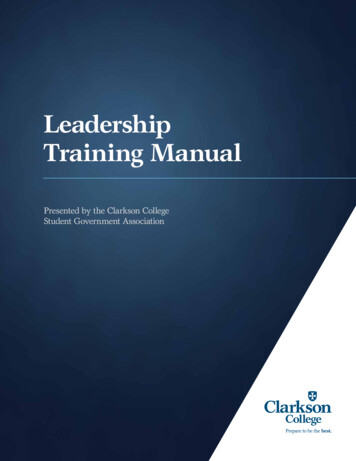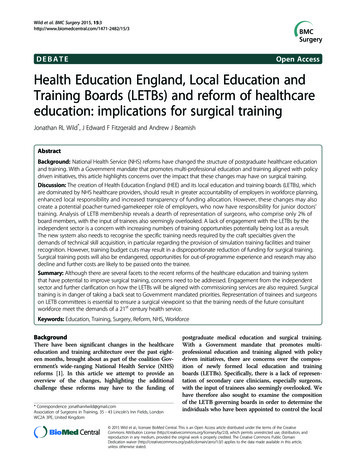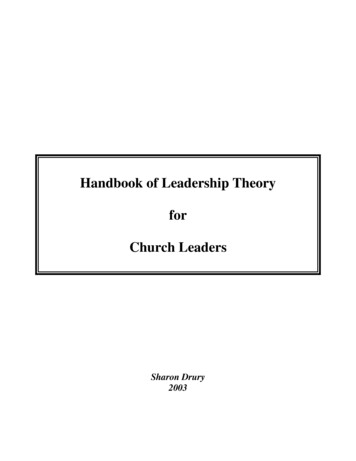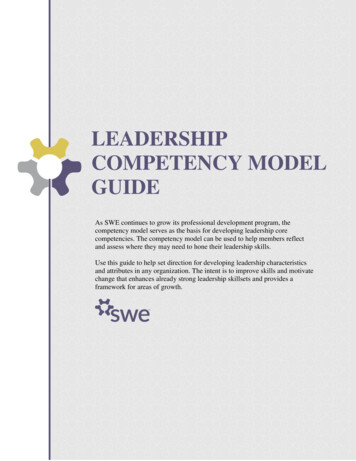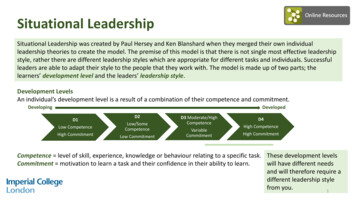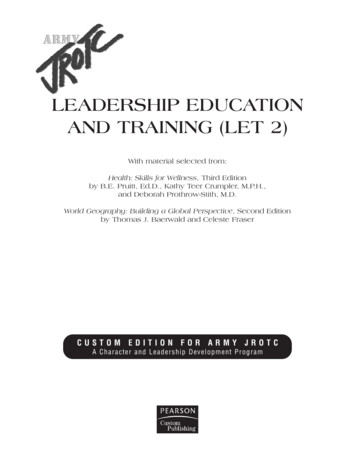
Transcription
LEADERSHIP EDUCATIONAND TRAINING (LET 2)With material selected from:Health: Skills for Wellness, Third Editionby B.E. Pruitt, Ed.D., Kathy Teer Crumpler, M.P.H.,and Deborah Prothrow-Stith, M.D.World Geography: Building a Global Perspective, Second Editionby Thomas J. Baerwald and Celeste FraserCUSTOM EDITION FOR ARMY JROTCA Character and Leadership Development Program
Cover images courtesy of Army JROTC.Excerpts taken from:Health: Skills for Wellness, Third Editionby B.E. (Buzz) Pruitt, Ed.D., Kathy Teer Crumpler, M.P.H., and Deborah Prothrow-Stith, M.D.Copyright 2001 by Prentice-Hall, Inc.A Pearson Education CompanyUpper Saddle River, New Jersey 07458World Geography: Building a Global Perspective, Second Editionby Thomas J. Baerwald and Celeste FraserCopyright 2002 by Prentice-Hall, Inc.Copyright 2005, 2002 by Pearson Custom PublishingAll rights reserved.This copyright covers material written expressly for this volume by the editor/s as well as the compilation itself. It does notcover the individual selections herein that first appeared elsewhere. Permission to reprint these has been obtained by PearsonCustom Publishing for this edition only. Further reproduction by any means, electronic or mechanical, includingphotocopying and recording, or by any information storage or retrieval system, must be arranged with the individualcopyright holders noted.Printed in the United States of America10 9 8 7 6 5 4 3 2 1ISBN 0-536-85201-42004420243DG/JSPlease visit our web site at www.pearsoncustom.comPEARSON CUSTOM PUBLISHING75 Arlington Street, Suite 300, Boston, MA 02116A Pearson Education Company
Brief ContentsUnit 4Wellness, Fitness, and First Aid 1Chapter 1Achieving a Healthy Lifestyle2Chapter 2 First Aid for Emergency andNon-Emergency Situations22Chapter 396Drug AwarenessUnit 5 Geography andEarth Science139Chapter 1140Map SkillsUnit 6 Citizenship in AmericanHistory and Government149Chapter 1 You the People—Citizenship skills150
ivBrief ContentsChapter 2 Foundations of theAmerican Political System193Chapter 3Creating the Constitution266Chapter 6The Bill of Rights304Chapter 7 Citizen Roles in AmericanDemocracy324Appendix Mandatory Core ServiceLearning355Chapter 8 Making a Difference withService Learning356Index377
Table of ContentsUnit 4Wellness, Fitness, and First Aid 1Chapter 1Lesson 3Lesson 4Achieving a Healthy Lifestyle2You Are What You EatNutrition—Nourishing Your Body310Chapter 2 First Aid for Emergency andNon-Emergency Situations22Lesson 1 The Need for First Aid/Your ResponseLesson 2 The First Life-Saving StepsLesson 3 Controlling BleedingLesson 4 Treating for Shock and ImmobilizingFracturesLesson 5 First Aid for BurnsLesson 6 First Aid for Poisons, Wounds,and BruisesLesson 7 Heat InjuriesLesson 8 Cold Weather InjuriesLesson 9 Bites, Stings, and Poisonous Hazards233039465464727786
viTable of ContentsChapter 3Drug Awareness96Lesson 1 Use and Effects of Drugs, Alcohol,and Substances97Lesson 2 Critical Decisions about Substances 122Unit 5 Geography and Earth Science 139Chapter 1Lesson 2Map SkillsIntroduction to Maps140141Unit 6 Citizenship in American Historyand Government149Chapter 1 You the People—Citizenship SkillsLesson 1Lesson 2Lesson 3Lesson 4Lesson 5The PreambleCitizenship SkillsSmall Group MeetingsRepresentative Group SessionIntroduction to Chief Justice 150151156168180186Chapter 2 Foundations of the AmericanPolitical System193Lesson 1 Our Natural RightsLesson 2 Developing Republican GovernmentLesson 3 British Origins of AmericanConstitutionalismLesson 4 Colonial Government—Basic Rightsand Constitutional GovernmentLesson 5 State Constitutions194210226239256
Table of ContentsChapter 3Lesson 1Lesson 2Lesson 3Creating the ConstitutionArticles of Confederation 1781Creating Our ConstitutionBalancing the PowerChapter 6The Bill of RightsLesson 6 Protection of Rights Within theJudicial SystemLesson 7 Military Justice SystemChapter 7 Citizen Roles inAmerican DemocracyLesson 1 Roles of CitizensLesson 2 New Citizenship andConstitutional IssuesLesson 3 Constitutionalism andOther Countries266267277288304305314324325337347Appendix Mandatory Core ServiceLearning355Chapter 8 Making a Difference withService Learning356Lesson 1 Orientation to Service LearningLesson 2 Plan and Train for Your ExploratoryProjectLesson 3 Project Reflection and IntegrationIndex357363369377vii
viiiTable of Contents
Unit 4Wellness, Fitness,and First Aid
Chapter 1Achieving a HealthyLifestyle
Lesson 3Key imulantvitaminsWhat You Will Learn to Do Evaluate how diet impacts lifeLinked Core Abilities Take responsibility for your actions and choicesSkills and Knowledge You Will Gain along the Way Explain how calories consumed verses calories used affects body weight Identify the daily-required food and portions Identify sources and benefits of fiber in diet Describe the importance of waterChapter 1You Are What You Eat
4Chapter 1Achieving a Healthy Lifestyle Describe the possible effects of a diet high in fat and cholesterol Explain why salt, sugar, and caffeine should be used in moderation Define key words contained in this lessonIntroductionKey Note Termnutrients – substances found infood that nourishthe body.deficient – havingtoo little of something, such as anutrient in the body.fats – nutrientsmade up of fattyacids that are insoluble in water andprovide energy tothe body.A healthy lifestyle includes good nutrition as well as exercise. You need to eatwell to maintain an exercise program. After all, just as a car will not run withoutfuel, your body will not work properly without the right nutrients. Eating a balanced diet also helps you maintain proper weight and lowers your risk of disease. This lesson explains the importance of a proper diet to your health.Americans live in a fast-paced environment and frequently eat on the run. Eating on the run too often, however, may affect your nutrition and weight. You canend up consuming too many fats and too few vegetables and fruit, leaving youoverweight and/or deficient in certain nutrients. Learning to eat balancedmeals, even on the run, contributes to your overall well-being by: helping to maintain proper weight providing energy for physical activity supplying nutrients for good healthNoteAlthough too many fats can be bad for you, your body needs a certain amount of fatfrom the foods you eat. Many necessary vitamins are fat-soluable only, and withoutfat, these vitamins cannot be absorbed.Key Note Termcalories – theamount of energy ittakes to raise thetemperature of onekilogram of waterone degree Celsius; ameasurement ofenergy.metabolism – thechemical process bywhich the bodyproduces energyand maintains vitalfunctions.Balancing CaloriesYou must eat to fuel your body. The more active you are, the more fuel yourbody requires. Even if you remain very still, your body uses a certain amount ofenergy, or calories, on basic functions that work automatically all the time tokeep you alive—such as your heart beating, your lungs inhaling, and yournerves delivering information. You do not have much control over the amountof calories used for these basic functions. Some people’s bodies naturally usemore calories to sustain their basic functions some people use less. It’s oftensaid that those who use more have a high metabolism, meaning they can eatmore and not gain weight.
Lesson 1You Are What You EatYour body also uses calories to do everything else throughout the day, frombrushing your teeth, to studying, to stretching. Unlike your basic functions;however, you can control how many calories you voluntarily use throughout theday by how active you are. For example, you will use more calories if you chooseto walk for an hour instead of watching television for an hour. Also, the moreeffort you put into an activity, the more calories you burn. For example, walkingat a brisk pace uses more calories than walking at a leisurely pace.When your body uses the same amount of calories daily than you eat daily,your weight stays the same. If you eat more calories than your body uses, yourbody stores the unused calories as fat and you gain weight. If you eat fewercalories than your body needs, your body uses the stored fat for energy andyou lose weight. It’s a balancing act between numbers of calories eaten andcalories used.Karen wonders why she keeps gaining weight—10 pounds over the last year.One Saturday, she and her friend, Andrea, meet at the local fast food restaurantfor lunch. While they wait in line, Andrea says she played tennis that morning.Karen admits she slept late and watched television. Andrea orders a small sodaand a salad with grilled chicken and light Italian dressing; then Karen orders adouble hamburger with mayonnaise only, large French fries, and a large chocolate milkshake.Andrea shakes her head and asks Karen if she ever eats fruit or vegetables. Karenshrugs and says “sometimes.” Andrea explains that she eats hamburgers andFrench fries every once in a while—in fact, she had that for lunch a few daysago, which is why she ordered a salad today. Andrea tells Karen that eating fruitand vegetables more often than fried foods and sweets helps her maintain herdesired weight, and she feels better, too. Karen thinks about this for a momentas they sit down to eat.Perhaps if Karen had access to the following calorie counts, she would reconsider what she ordered. Keep in mind that most people need only between 2,000and 3,000 total calories a day. Table 1.2.1 shows the difference between the twofood orders.NoteThe calories listed here are approximate; actual calories of these food items at different restaurants may vary.5
6Chapter 1Achieving a Healthy LifestyleTable 1.2.1: Karen and Andrea’s lunch ordersKaren’s OrderCalories Andrea’s OrderCaloriesPlain double hamburgerwith bun (1 4 pound of beef)540Salad with grilled chicken200Mayonnaise(1 tablespoon)100Light Italian salad dressing(2 tablespoons)50French fries (large order)360Chocolate milkshake (large)540Soda (small)150TOTAL1540TOTAL400Even if Karen did not want a salad, she could cut her calories considerably byordering a single hamburger with mustard and ketchup, a small milkshake, anda regular order of fries. She could also have lettuce and tomato on the burger toeat some vegetables. Her new calorie intake would look simliar to Table 1.2.2.If Karen really wants to lose those extra 10 pounds, however, she should skipthe milkshake and replace the fries with a small salad and light dressing. Thiswould reduce her calorie intake to about 400 for lunch. She should then getsome exercise like her friend Andrea. Playing tennis for an hour uses threeTable 1.2.2: An alternative to Andrea’s lunch orderAndrea’s orderPlain single hamburger with bun (2 ounce patty)Calories275Lettuce (1 2 cup)5Tomato (1 slice)5Mustard (1 tablespoon)8Ketchup (1 tablespoon)15French fries (regular order)220Chocolate milkshake (small)330TOTAL858
Lesson 1You Are What You Eat7times as many calories as watching television for an hour. If Karen sticks to eating sensibly and exercises daily, she will start using more calories than she eats,losing those extra pounds.The Importance of a Proper Diet to Your HealthJust as important as eating the correct amount of calories to supply your bodywith energy and maintain proper weight is what you eat to get those calories. Ifyou eat like Karen every day, you are giving your body too much fat, cholesterol,salt, and sugar, and denying your body many necessary nutrients. Many healthproblems are related to poor diets, and these problems can start when you areyoung. At your next physical examination, ask your doctor about your cholesterol, blood pressure, and blood sugar levels. You may be surprised to find youneed to change your diet to improve your health.What Should You Eat?The United States Department of Agriculture (USDA) developed the Food GuidePyramid to indicate how many servings of six different food groups you shouldeat daily to get the nutrients your body needs. If you follow these guidelines, youwill get enough vitamins and minerals to keep your body’s processes functioning properly, and you will have enough carbohydrates, protein, and fat to supplyyour body with energy. When you do not get enough of certain nutrients, youincrease your risk of disease. For example, if you do not get enough calcium, amineral found in milk products, almonds, sardines, leafy vegetables, and beans,you can develop osteoporosis.NoteTo see the current Food Guide Pyramid as offered by the USDA, check Your body also needs fiber, the only form of carbohydrate that is not an energysource. Fiber aids in digestion. It prevents cholesterol, fats, and other toxic materials from entering the bloodstream, and for this reason may lessen your chancesof cancer and heart disease. It also helps balance your blood sugar levels, so ithelps control diabetes. To obtain fiber, eat raw or lightly cooked vegetables, freshfruit, beans, nuts, and whole wheat or bran breads, cereals, and crackers.One final nutrient that you do not get from food that is vital to keeping you aliveis water. More than 65 percent of the body is water, and, as the body loses waterthrough normal activity and exercise, it must be replaced. Water aids in digestion, regulates temperature, carries vitamins and minerals to all parts of thebody, and is important for the removal of waste products from the kidneys. Drinka minimum of five to six glasses of water a day. On the days you exercise, youmay need to drink more.Key Note Termcarbohydrates – oneof the various neutralorganic compoundscomposed of carbon,hydrogen, andoxygen (includingstarches and sugars)produced by greenplants and used toprovide energy necessary for growth andother functions.minerals – naturalchemical elementsof the earth used bythe body to supplynecessary nutrition.osteoporosis – a condition characterizedby a calcium deficiency in the bonemass in which thebody pulls calciumfrom the bones,causing them to losetheir density andpossibly leading tofractures.protein – nutrientsthat are made ofamino acids andthat maintain bodytissues and supplyenergy to the body.vitamins – nutrientsthat occur naturallyin plant and animaltissue and arerequired for properfunction of the body.diabetes – a diseasethat causes too muchblood sugar to buildup in the body.
8Chapter 1Achieving a Healthy LifestyleEating in ModerationKey Note Termfiber – coarse foodmade mostly of carbohydrates, such asbran or lettuce thatserves to stimulateand aid the movement of food throughthe intestines.stimulant – a drink,drug, or other substance that speeds upthe activity of themind or body; a drugthat speeds up theactivities of the central nervous system,the heart, and otherorgans.Your body needs fat for energy, but too much fat in your diet can make you gainweight and can lead to high cholesterol. Cholesterol, a type of fat, is a natural,waxy substance produced by your body and found in animal products. Yourbody needs some cholesterol to remain healthy, but too much is harmful. Asshown in Figure 1.2.1, cholesterol forms plaque on artery walls, restricting theflow of blood within blood vessels. This leads to high blood pressure and anincreased risk of heart disease. To lower cholesterol levels, lower your intake offat by eating less meat, using oil-free dressings, avoiding fried foods, eating lowfat dairy products, and consuming lots of fiber.Many foods, especially prepackaged foods and restaurant foods, already haveadded salt, so do not shake on more. Too much salt in your diet forces your bodyto retain unnecessary water and may contribute to high blood pressure.Sugary foods like candy, soda, syrup, and table sugar supply you with caloriesand few (if any) nutrients. These foods contain “empty calories”—they give yourbody calories and nothing else. Avoid them while dieting, and do not eat themas a replacement for other foods that provide nutrition. Many fruits and vegetables naturally contain sugar, but they also provide many other important nutrients.Limit your intake of coffee, tea, and sodas that contain caffeine, a stimulant.Although caffeine temporarily reduces drowsiness and makes you more alert, inlarge quantities it can upset your stomach, make you nervous and irritable, keepyou awake when you want to sleep, and give you diarrhea.Figure 1.2.1: Cholesterolshown in artery walls.Clot
Lesson 1You Are What You Eat9ConclusionLesson Review1. Think about what you had for breakfast. How could you have balanced yourcalories better?2. Do you feel you have a slow or fast metabolism? How can you plan your mealswith this in mind?3. Looking at the food pyramid, what food group do you need to eat more or less of?4. Define the term “metabolism.”Chapter 1 Lesson ReviewYour body needs food for energy, just like a car needs fuel to run. How muchfood your body needs depends on how active you are and how many caloriesyour body uses to keep its basic functions operating. You know you are gettingthe right amount of calories from food when you maintain your ideal weight.Not only does food supply you with energy, but the right foods also provide thenutrients your body needs to operate properly and lower your risk of disease.Eating a healthy, balanced diet and exercising regularly increase your chances ofa long, strong, and disease-free life.
Lesson 4Chapter 1Nutrition—Nourishing Your BodyKey Termsamino acidscomplex carbohydratesfat soluble vitaminsmono-unsaturated fatspoly-unsaturated fatsReferenced Daily Intake (RDI)saturated fatssimple carbohydrateswater soluble vitaminsWhat You Will Learn to Do Analyze how well you meet nutrient guidelinesLinked Core Abilities Take responsibility for your actions and choicesSkills and Knowledge You Will Gain along the Way Explain the six nutrients your body requires Explain the difference between simple and complex carbohydrates Describe the role fat and cholesterol play in body functioning Compare saturated and unsaturated fats Describe ways to reduce cholesterol levels
Lesson 4Nutrition—Nourishing Your Body Compare the functions of vitamins, carbohydrates, fats and proteins Identify food sources of vitamins and minerals Define key words contained in this lessonIntroductionNutrition is the science of nourishing the body properly to reach the higher levels of dynamic living. This lesson will introduce you to the six nutrients, andshow you how to best provide them in a diet that is well rounded yet diversified.You will learn the newest methods available in how to choose your foods andhow to read labels. Finally, you will better understand how to maintain a leanbody, free from the damaging effects of carrying too much personal fat.Our diets have radically changed during the past 35 years. With the advent offast-food outlets, an increase in dual-career parents, and sky-rocketing numbersof single-parent households, most Americans now have a hurry-up lifestylewhere proper eating habits take a back seat to convenience and lack of time.Knowing that our lifestyles are busy and sometimes hurried, it is very importantthat young adults have at least a basic understanding of nutrients, how toobtain them, and how to control fat. This knowledge will lead to a moredynamic life and a higher quality lifestyle. The six types of nutrients are carbohydrates, fats, proteins, vitamins, minerals, and water.We also refer to the first three nutrients, carbohydrates, fats, and proteins, asfoodstuffs. They give us the energy for all of the bodily processes. When ourbody uses the foodstuffs, it releases energy. We measure this energy in calories.NoteTo learn more about calories, see Unit 4, Chapter 1, Lesson 2, “You Are WhatYou Eat.”CarbohydratesCarbohydrates are the starches and sugars found in fruits, grains, and vegetables. They have a caloric value of four calories per gram and supply us withshort- and long-term energy to accomplish everything from thinking andbreathing to running a race.11
12Key Note Termsimplecarbohydrate – asugar that is found inthe body in its simplestate and suppliedthe body with shortterm energy.complexcarbohydrates – acarbohydrate that isformed by the bodyafter the conversionof extra glucose; itsupplies the bodywith long-termenergy.Key Note Termfat soluble vitamin –a vitamin that isabsorbed throughthe intestinal tractwith the help of fatsand is stored in thebody.mono-unsaturatedfats – oil or fat that isliquid at room temperature, is low inhydrogen, and canlower the level ofblood cholesterol.poly-unsaturatedfats – an oil of fattyacid containing morethan one double ortriple bond and istherefore cholesteroldefensive.saturated fats – a fatthat does not melt atroom temperatureand can raise theblood cholesterollevel.Chapter 1Achieving a Healthy LifestyleThe short-term carbohydrates are the sugars, or simple carbohydrates, whichare quickly digested and absorbed into the blood. The most important simplesugar is glucose, or blood sugar. Before the body’s cells can use other simplesugars (such as fructose, sucrose, and lactose) for energy, a change must occurconverting them into glucose. Many sugary foods are sources of simple carbohydrates; however, those such as soda and candy have few other nutrients whilefruit is an excellent source of simple carbohydrates and contains many othervitamins and minerals as well.The long-term carbohydrates are starches, or complex carbohydrates, whichare made up of combinations of simple sugars. They take longer to digestbecause the body must break them into simple sugars (glucose) before they canenter the bloodstream. When your body has extra glucose that it does not needimmediately for energy, it converts it into the complex carbohydrate glycogenand stores it in the muscles and liver to be released later when energy is needed,usually for short periods of strenuous activity. After your muscles and liver storeas much glycogen as they can hold, your body changes the rest to body fat forlong-term energy. Long distance runners use carbohydrate loading (eating largequantities of carbohydrates) to have the long-term energy they need to complete the race.Good sources of complex carbohydrates are grains (such as bread, cereal, pasta,and rice) and starchy vegetables (such as peas, corn, beans, and potatoes).These starchy foods are also important sources of vitamins, minerals, and fiber.Fiber provides no calories, but is roughage that aids in the movement of foodthrough the digestive system.Nourishing Your Body’s Fuel with FatsFats, or lipids, perform the vital roles of maintaining body temperature, insulatingbody organs, providing the body with stored energy, and carrying the fat solublevitamins A, D, E, and K to the cells. One gram of fat is the equivalent of nine calories of energy, more than twice the amount of carbohydrates; therefore, minimumconsumption of fats is the most sensible approach to maintaining a lean body fatcontent.Triglycerides are the primary fats in the foods we eat, as well as the fats stored inbody tissue. They include saturated fat, which mainly comes from animalsources and does not melt at room temperature, and mono-unsaturated andpoly-unsaturated fats, which are usually liquid oils of vegetable origin. Whenyou eat too many calories, your liver changes them into triglycerides and storesthem as fat. When you eat too many saturated fats, your liver makes more cholesterol than your body needs, which is unhealthy.
Lesson 4Nutrition—Nourishing Your Body13Cardiovascular disease is the main killer of AmericansYour liver already produces about 1,000 milligrams (mg) of cholesterol daily anddiet adds another 400 to 500 mg. Cholesterol, a waxy, sticky substance found in animal and human tissue, insulates nerves and forms hormones, cell membranes, vitamin D, and bile to aid in food digestion.Your blood carries cholesterol by way of lipoproteins, with low density lipoproteins(LDL) carrying cholesterol from the liver to the cells to accomplish the functionsmentioned. Unfortunately, the LDLs deposit any cholesterol that is not needed bythe cells in the arteries, giving them the nickname of the “bad guys.” Cholesterolaccumulated on the inside walls of the arteries is a factor in the development ofatherosclerosis. Eventually, cardiovascular disease, in the form of a heart attack orstroke, may result.The high density lipoproteins (HDL) carry the extra cholesterol in your blood to theliver to dispose of it, thus preventing cholesterol from building up in the arteries.For this reason, HDLs are known as the “good guys.” To keep cholesterol at a normal level in the body, you must lower LDL levels and raise HDL levels. Steps youcan take to accomplish this are to eat less fat, especially saturated fat, maintainappropriate body weight, and participate in a regular exercise program. Eatingmore fiber will also help because it binds with cholesterol and carries it out of thebody; and consuming mono-unsaturated fats, such as olive, canola, and peanutoils, raises HDLs.Nourishing Your Body with ProteinsThe body contains substances called proteins in every cell. They aid in thedevelopment and maintenance of muscle, bone, skin, and blood. Proteins arealso the key behind keeping the immune system strong. They control thechemical activities in the body that transport oxygen, iron, and nutrients to thebody cells. The body can also use protein for energy if it is low on carbohydrates and fats; but in most cases, its role as an energy source is minor. Proteins, like carbohydrates, contain four calories per gram.The building blocks of protein are the amino acids. These chains of carbon,hydrogen, oxygen, and nitrogen linked together in different ways control all ofthe activities mentioned above. There are 22 amino acids found in the humantissue, but the body cannot manufacture all of them. Eight (nine for children)amino acids, known as the essential amino acids, must come from the food weeat since the body cannot produce them. We refer to the food products thatcontain all eight essential amino acids as having complete proteins. The bestsources of complete proteins are meat, fish, poultry, and dairy products. Plantfoods generally contain incomplete proteins since they are either low on or lackan essential amino acid. However, plant foods can be combined easily, such asrice and beans or peanut butter and bread, to include all essential amino acidsin high enough amounts to form a complete protein.The remaining 14 amino acids are known as the nonessential amino acids.They are still necessary for bodily functioning, but are called “nonessential”because they do not have to be supplied in the diet. Instead, the body manufactures nonessential amino acids itself.Key Note Termamino acids – thebasic units ofproteins, producedby living cells orobtained as anessential componentof a diet.
14Chapter 1Achieving a Healthy LifestyleKeep in mind that although animal and dairy products are sources of completeproteins, many are often high in fat as well. As you will read later in this text,Americans get most of their protein from animal sources instead of from combinations of complex carbohydrates. You will have a healthier diet and still meetyour protein needs if you consume less fatty foods and more carbohydrates inthe forms of grains and vegetables.Regulating Your Body with Vitamins, Minerals,and WaterKey Note Termwater solublevitamin – a vitaminthat is dissolved inthe water of tissues.Referenced DailyIntake (RDI) –standards developedby the United Statesgovernment for theregulation of vitaminand mineral requirements.Vitamins are promoters of health and wellness. Unlike the carbohydrates, fats,and proteins, the body does not digest vitamins; instead, food products releasethem and your body tissues absorb them. Vitamins are classified as either fatsoluble or water soluble. With the help of fats, the intestinal tract absorbs fat soluble vitamins (A, D, E, and K) and stores them in the body. The water in the tissues dissolves the water soluble vitamins (B complex and C).Many countries have standards for vitamin and mineral requirements to recommend daily amounts needed for good health. For example, the standards for theUnited States are the Referenced Daily Intakes (RDI). From time to time, thefederal government reviews these standards and proposes new ones as researchcontinues and more complete information about vitamins and minerals is discovered. Table 1.3.1 shows the current U.S. RDI for vitamins and minerals.MineralsMinerals are elements found in the environment that help regulate the bodilyprocesses. Without minerals, the body cannot absorb vitamins. Macrominerals,shown in Table 1.3.2, are minerals that the body needs in large amounts. Theseare calcium, phosphorus, magnesium, potassium, sulfur, sodium, and chloride.Although sodium is a macromineral, many Americans consume too much of it,which can contribute to high blood pressure. High blood pressure, in turn, cancontribute to cardiovascular disease. On the other hand, many Americans do notconsume enough calcium, and a calcium deficiency can lead to osteoporosislater in life.Although the body only needs trace minerals (such as selenium, manganese,molybdenum, iron, copper, zinc, iodine, and chromium, shown in Table 1.3.3)in very small amounts, they are also essential for proper functioning of the body.For example, an iron deficiency can reduce the number and size of red bloodcells, causing weakness, sleepiness, and headaches.
Lesson 415Nutrition—Nourishing Your BodyTable 1.3.1: VitaminsVitaminU.S. RDIFunctionsSourcesA5000InternationalUnits (IU)Helps maintain eyes, skin,and linings of the nose, mouth,digestive, and urinary tractsLiver, dairy products, fortifiedmargarine, orange fruits andvegetables, dark-green vegetablesB-1 (Thiamin)1.5 mgHelps convert carbohydratesinto energyYeast, rice, whole-grain andenriched br
Americans live in a fast-paced environment and frequently eat on the run. Eat-ing on the run too often, however, may affect your nutrition and weight. You can end up consuming too many fats and too few vegetables and fruit, leaving you overweight and/or deficient in cer
